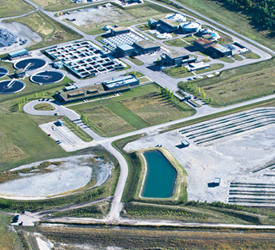The University of Calgary is in a unique position to tackle some of the most sobering and complex questions of our time, such as, “How can we sustain the delicate environment we rely on as our population grows?”
This question has long taxed top-tier minds, particularly in protecting clean water, given that 99 per cent of the world’s water is either undrinkable or frozen in ice caps and glaciers. With a scarce one per cent to steward, the issue is becoming dire as the effects of emerging pollutants are increasingly understood.
From gender-bending hormones that render fish infertile, to the role wastewater plays in the spread of disease, scientists are discovering what these alarming signals mean for public health and for healthy ecosystems. The need to find ways to eliminate the harm these contaminants are causing has never been more critical.
— UCalgary President Elizabeth Cannon
These very issues form some of the research currently being advanced at UCalgary’s new $38.5-million Advancing Canadian Wastewater Assets (ACWA) facility, the physical result of an idea conceived 15 years ago through the vision of world-class scholars.
A critical partnership between the UCalgary and the City of Calgary allows university researchers to work alongside municipal operators in a fully contained research facility within the Pine Creek Wastewater Treatment Centre in south Calgary. This small, but highly technical wastewater treatment plant includes 12 naturalized, experimental streams that replicate the Jumping Pound Creek system.
These copycat streams can be dosed with contaminants to discover the benefits of advanced treatments in large-scale, controlled experiments.
“There is no other facility like ACWA and we expect it to offer groundbreaking water research with global impact,” says UCalgary President Elizabeth Cannon. “It is a place where researchers, practitioners and industry can work together to solve important problems facing cities everywhere. It represents a new way of doing basic and applied science; a way that results in true discovery and innovation that benefits society as a whole.”
ACWA’s three main themes related to water include: engineering technologies, public health protection and aquatic ecology and ecotoxicology.

City laboratory scientists work with the university at this location and also at locations on UCalgary’s campus to develop new methods to test for emerging pathogens and substances of concern. In fact, some of the graduate students involved in ACWA research are also City employees working in the wastewater system.
Processes refined through the ACWA initiative will have application far beyond municipal wastewater treatment. For example, they could be used to monitor water activity and quality remotely in isolated communities, and they could also lead to the development of “smart sewers” that live-monitor effluent before it reaches treatment plants.
In the energy industry, the technologies could, for example, be applied to test and treat wastewater at remote extraction or processing sites.
Results from ACWA research will inform decision-making, and leverage resources, knowledge and skills. New technologies and substances could be assessed in the controlled environment, with results directly influencing policy and regulations.
“ACWA is unique and gives us this wonderful living laboratory,” says Glen Armstrong, a professor in microbiology, immunology and infectious diseases at UCalgary. “It gives us this opportunity to be proactive in a microbial world before it becomes apparent in hospital rooms and clinics.” U
To learn more, visit ucalgary.ca/acwa













 Cecilia Chung, BSc’10, MSc’13, gathering water samples from the Bow River in Banff National Park
Cecilia Chung, BSc’10, MSc’13, gathering water samples from the Bow River in Banff National Park